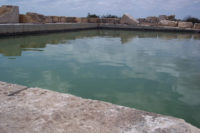CHICAGO, IL -- Tough new sustainability standards for natural stone were recently announced by the Natural Stone Council (NSC), which said they would level the playing field between man's oldest building material and other building components. The product of nearly five years in the development stage, the new standard, called "ANSI/NSC-373, Sustainable Production of Natural Dimension Stone" will allow quarriers, processors and fabricators of natural stone who consistently meet or exceed the standards to label and promote their stone products as "certified Genuine Stone®." The associated Chain of Custody standard is a companion document that tracks the material as it moves from the quarry through manufacturing and through the supply chain to the ultimate destination, including the jobsite or the end user. Distributors can obtain certification under the Chain of Custody protocols.
The standards were unveiled at the 2014 American Institute of Architects (AIA) Convention, which took place from June 26 to 28 at McCormick Place in Chicago, IL.
"Since the architectural/design community has been leading the way in the move to more green building and has been eagerly awaiting this development by our industry, it was only natural to announce our new standards in this venue," said Moe Bohrer, Chairman of the NSC. "The NSC is made up of a dozen stone industry trade organizations. Natural stone was used as a key building material long before architects were employed to design them. If you travel the world and see some of the magnificent structures made of stone still standing after hundreds of years, it's quite obvious there is nothing more durable and versatile than stone. But today, sustainability means more than just having a long and useful lifespan, though that is still important.
"Accounting for the sustainability of natural stone now encompasses how the stone is quarried, processed and transported, and how its use impacts the facilities, environments and people who work with it," Bohrer went on to say. "The entire process of determining a product's sustainability is part of the growing and global green building movement."
According to Duke Pointer, Executive Director of NSC, the new standard establishes well defined metrics for environmental, economic and social responsibilities. He said it was designed to be recognized by green building market drivers as indicators of leadership of sustainability performance.
"In the end, the standard was built to assure architects, designers, building owners and the consuming public that the stone that's brought from next door, around the country or across the world is coming in a manner that minimizes how it affects the environment," said Pointer. He explained that the standard covers nine facets of a quarrier and fabricator's operation with an optional element called innovation. The nine required facets include: water usage and recycling, custody and transportation, site and plant management, land reclamation and adaptive use, corporate governance, energy usage and conservation, management of excess process materials and waste, safer chemical and materials management, and human and health considerations.
"Each company's facility is certified on a site-specific basis," said Pointer. "For instance, if a company has a dozen quarries, it can obtain certification on a site specific basis, one or all 12. The same goes for fabrication plants."
There are 18 different requirements under the NSC373 standard with a total of 41 possible points. There are four different levels of certification -- bronze, silver, gold or platinum, and companies will be able to use that certification to differentiate themselves from the competition. If NSF International is used as the third party certifier, the additional benefit is the appropriate Genuine Stone® seal can be applied to individual blocks, slabs, finished piece, etc. or used in promotional activities. The more points a company earns on the way to the maximum of 41, the higher the level designation.
"Manage water recycling and energy usage better and earn more points toward a higher designation," explained Pointer. "Each facility must be recertified every four years."
There is also an important supporting standard to NSC373 which tracks the Chain of Custody of the stones as the material moves from the quarry through manufacturing and through the supply chain to the ultimate destination, including the jobsite or the end user.
"Every step of the way, whoever is handling the product must conform to the standard or the stone loses is certification," Pointer went on to say. "Stone distributors achieve a Chain of Custody certification when they qualify."
Bohrer said The NSC expects several major quarriers and fabricators to apply immediately for certification, a process that is expected to take two to four months and involves on-site inspections by a third party certifier. NSF International, which worked with NSC to develop NSC373, is the preferred third-party certifier and will handle the paperwork review and site visits.
"NSC373 was developed using the consensus based ANSI (American National Standards Institute) process, and can be applied internationally, with certification by a third-party certifier like NSF International," said Bohrer.
For further information, contact Duke Pointer, Executive Director of NSC, at dukepointer@naturalstonecouncil.org or Natural Stone Council, PO Box 539, Hollis, NH 03049.

